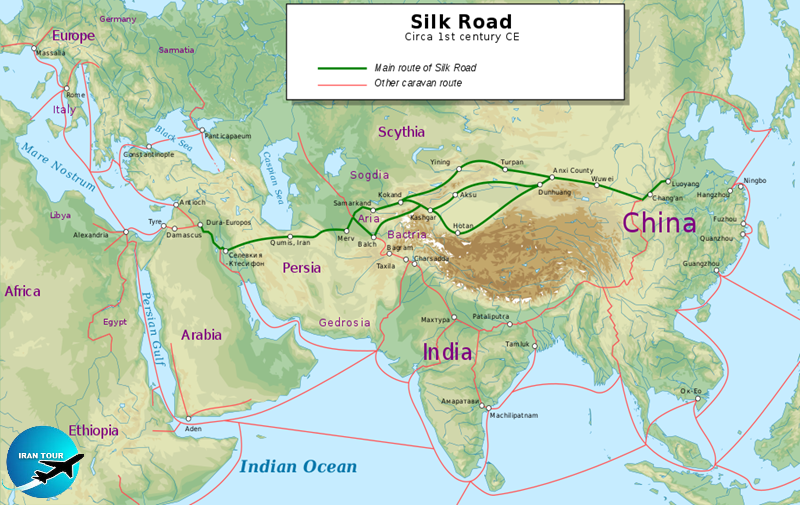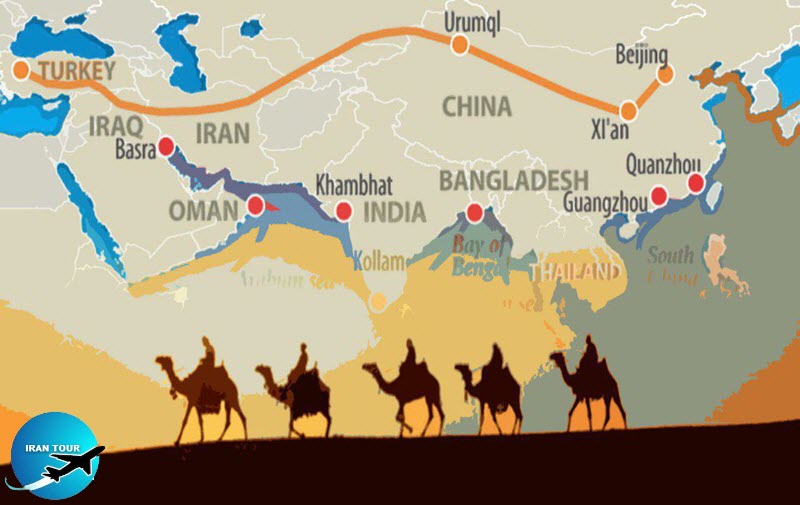Iran a bridge between East and West
By: Mohammad Hassan Talebian
Silk Road
In ancient times the Silk Road started from Tian Huang town in China. Then it continued to Gansu Province at the north, entered the present Eastern Turkistan, crossed central Afghanistan, and continued to Samarqand and Bukhara. From Bukhara, the highway continued to Marv, Sarakhs, Nishapur, and Gorgan and reached Rey. From Rey, the road continued to Qazvin, Zanjan, Tabriz, and Yerevan and from Yerevan, it continued to Trabzon port at the Black Sea.
 |
After the road made a circle and reached a port in Syria. A branch of the Silk Road ran from Samarqand to Kharazm, then to Hashtarkhan, and ended at Danube River and Sea of Azov in Europe. The most important commodity transited through Iran in ancient times was silk, but since the Iranians imported a great deal of silk and converted it to the fabric they were able to sell their silk fabric to European countries at a good price. Encouraged by Sogdians the Turks asked King Anooshirvan of the Sassanid Dynasty to allow them to transit their silk through Iran but he refused such a permit. Later on, in order to avoid crossing the giant central desert in China, the Chinese emperors invented a new sea route from ports east of China and shipped the merchandise towards the west. As a result, the Silk Road was divided into northern and southern branches. As mentioned before the northern route, known as Silk Road, started from Tian Huang town, then crossed several Chinese provinces before arriving at the great central desert. After crossing the great central desert it was divided into three branches. Two roads circled the great desert and the third road continued from the south of it. After crossing the southern towns of China the southern road reached the north of India; then it took a northward turn and continued to Greater Khorasan and present Iran. After that, it reached the Caspian Sea and joined the northern road. From the fourteenth century onward another sea route was established from China which was separated from the older road.
 |
Spice Road
Spice Road was a corridor for the transportation of Indian spices to Europe. Its main route didn't deviate much from the Silk Road. The only difference between the two roads was that the silk was exported from China and the spice was exported from India. Spice road was a mountainous road and a masterpiece of engineering. Some of the side branches were connected to Silk Road through mountains in Fars Province. It is said the stone-paved Spice Road was built four hundred years ago for the transportation of spices and similar goods. Part of the stone-paved Spice Road has remained intact and one can see monuments beside that road such as a water reservoir over the mountain. Some historians believe that a bridge had been built in Fars Province over the Spice Road but it has disappeared. Jean Chardin, a famous French traveler, who visited Iran in the sixteenth century, passed the Spice Road and mentioned it in his travelogue. He says Mount Alborz is the most difficult and dangerous route in Iran and the only passage through that mountain is a stone-paved road. Chardin says there were three water reservoirs in Mount Alborz which were dry because of drought.
-
Details
-
Category: IRAN Blog

